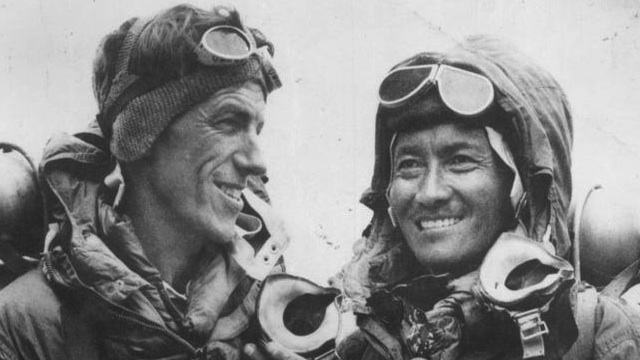SUMMARY
This is AI generated summarization, which may have errors. For context, always refer to the full article.

KATHMANDU, Nepal – Nepal on Wednesday, May 29, marked 60 years since the first ascent of Everest, celebrating the pioneering climbers whose bravery spawned an industry that many mountaineers fear is now ruining the world’s highest peak.
Four days of ceremonies dubbed the “Everest Diamond Jubilee” ended Wednesday with family members of Edmund Hillary and Tenzing Norgay, the first summiteers, laying garlands on statues of the legendary pair.
A host of famous mountaineers who followed in their footsteps were handed letters of appreciation at a gala dinner inside the grounds of Nepal’s former royal palace in Kathmandu.
“On this day, late Tenzing Norgay and Sir Edmund Hillary created a milestone of being the first human beings on the pinnacle of earth, Mount Everest. ” Khilraj Regmi, Nepal’s Prime Minister, told the gathering.
“That historic success brought Nepal to the limelight of mountaineering tourism and opened a new era of adventure activities,” he said.
The British-funded trip to the peak, which is 8,848 meters (29,029 feet) above sea level, changed mountaineering forever and made the New Zealander and his Nepalese guide household names in many parts of the world.
“Hillary and Tenzing were rock stars of the 1950s and into the 1960s,” Hillary’s son Peter told AFP. “The biggest thing about 1953 is that they were going into the unknown.”
But while their groundbreaking achievements were lauded, controversy over some contemporary climbers’ behavior on Everest came under attack.
Legendary mountaineer Reinhold Messner, the first man to reach the summit of the world’s highest mountain without supplementary oxygen, criticized European climbers involved in a fight with Nepalese guides earlier this month.
“Climbers who cross ladders set by Sherpas at the Khumbu Icefall, then go up without ropes and claim to be special are parasites,” Messner told a crowd at the British embassy in Kathmandu, in an apparent reference to Italian Simone Moro and Swiss Ueli Steck.
The Nepalese guides involved in the incident said that the Europeans had ignored a request to stay in base camp while ropes were fixed for commercial climbers.
While Everest is a major revenue-earner for impoverished Nepal, many in the climbing community are concerned about the dangers of over-commercialization.
Recent photographs show queues of climbers waiting their turn to reach the summit, as well as growing mounds of rubbish.
“Everest has turned into a playground for people with all sorts of interests,” veteran climber Temba Tsheri Sherpa, who runs an expedition company, lamented in an interview with AFP.

“All they want is to set new records and they seem to be willing to pay thousands of dollars in order to fulfil their dreams.”
Norgay’s grandson Tenzing called on the Nepalese government to protect the peak.
“Our leaders should understand the value of the mountains,” he said. “We should not sell Nepal as a cheap destination.”
More than 3,500 people have so far reached the peak, according to government figures.
This season 540 have made it, including the first female amputee, the first women from Saudi Arabia and Pakistan and the first armless man.
Two Nepalese and Japanese octogenarians have also faced off to claim the record for the world’s oldest person to reach the summit — Nepal’s Min Bahadur Sherchan, 81, cancelled his new bid on Wednesday, ceding the record to Yuichiro Miura, 80, who reached the top last week.
Kancha Sherpa, now 81, worked as a porter on the maiden expedition, which he remembers as an arduous but ultimately joyous affair — although he regrets that the glory is not more equally shared among the team.
“One thousand, two hundred coolies (porters) were gathered together at Bhaktapur near Kathmandu,” he told AFP.
“Everyone walked from there because there weren’t any roads, no motor vehicles, no planes. It took us 16 days to reach Namche,” which is today the start of the Everest route, he added.
The peak, named Everest in 1852 during Britain’s colonial rule of India, is called Chomolungma — meaning “Holy Mother” — in the local Sherpa language. The Nepalese government dubbed it Sagarmatha in the 1960s, meaning “Head Touching the Sky”.
Hillary’s son Peter, and Norgay’s son Jamling, both now mountaineers, joined Queen Elizabeth II at a diamond jubilee event at the Royal Geographical Society in London later on Wednesday. – Rappler.com
Add a comment
How does this make you feel?
There are no comments yet. Add your comment to start the conversation.